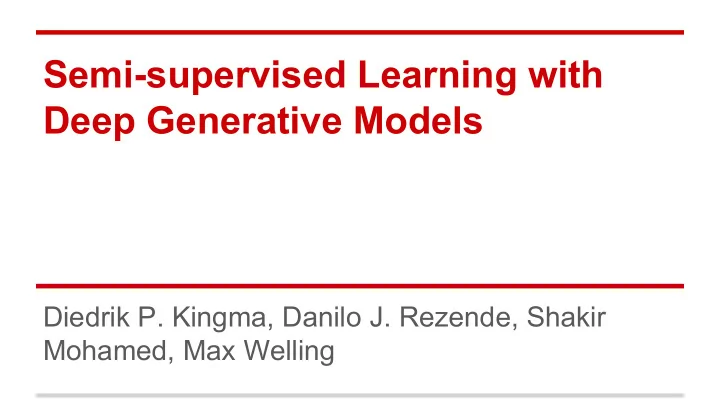

Semi-supervised Learning with Deep Generative Models Diedrik P. Kingma, Danilo J. Rezende, Shakir Mohamed, Max Welling
What is Deep Learning very good at? Classifying highly structured data -ImageNet -Part of Speech Tagging -MNIST Sensitive to signals even in obscured or translated scenarios
How smart are Neural Nets? Constrained to training classes Labeled data is costly ? How do we generalize to more classes? More complex concepts?
Solution: Semi-supervised Learning Learning in the situation of very little labeled (supervised) data Use accessible data to improve decision boundaries and better classify unlabeled data A real attempt at inductive reasoning?
Previous Work Self Training Scheme (Rosenberg et al.) Transductive SVMs (Joachims) Graph Based Methods (Blum et al., Zhu et al.) Manifold Tangent Classifier (Ranzato and Szummer)
Significant Contributions Semi-supervised learning with generative models formed by the fusion of both: -Probabilistic Models -Deep Neural Networks Stochastic Variational Inference for both model and variational parameters Results: State of the art-classification, learns to separate content types from styles
Components M1-Latent Feature Discriminative Model M2-Generative Semi-Supervised Model M1+M2 Stacked Generative Semi-Supervised Model Optimization of Model using Variational Inference
Latent-Feature Discriminative Model x Generative The probabilities are formed by a non-linear transformations of a set of latent variables z . z Non-linear functions are neural networks! Discriminative x
Generative semi-supervised Model x Class labels are treated as latent variables, and z is an Generative additional latent variable z y Again, the likelihood function is parameterized Discriminative by a non-linear transformation of latent x variables, which are deep neural networks
Stacked Model (M1+M2) Use the latent variables from M1 (z 1 ), to learn M2. Instead of raw data (x). where Conditionals are parameterized as deep neural nets as in previous models.
Optimization via Variational Inference Posteriors are non-linear dependencies between random variables and thus extremely difficult to compute (Jensen’s Approximate with another function Inequality) that’s “close” and computable Establish a lower bound objective
In our case...
Optimization Algorithms (EM variant)
Results MNIST
Classes vs. Styles
Other Data Sets
Classification
Conclusion Innovative model design, especially using generative models to perform classification tasks Implementation of variational inference Results in powerful model with intra-class variation understanding Could these be used with Convolutional Neural Nets?
Recommend
More recommend